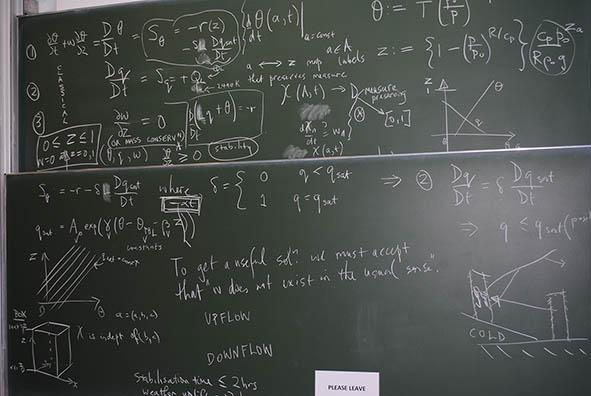Challenges
The challenges that were tackled at the study group were formulated in collaboration with the following stakeholders: Fugro GEOS, JBA Trust, the Met Office and the Environment Agency.

JBA Trust
The challenge that was presented by JBA Trust was Identification of Coherent Weather Features in Three Dimensions. Identification of weather features is crucial to both understanding the atmospheric processes occurring and predicting how the atmosphere may evolve. Two examples of weather features that have been objectively identified and how that information is used were presented. The identification of weather features in three dimensions presented an interesting problem that was explored at the Study Group.
Since the workshop, the report prepared by those working on the JBA Trust challenge has been peer reviewed and revised.
Fugro GEOS
The challenge that was presented by Fugro GEOS is Statistical Framework for Utilisation of Modelled Data for Tropical Cyclones. We are increasingly asked to produce wind and wave design criteria e.g. 100-year or 10,000-year return period values for tropical cyclones in regions where such events occur relatively infrequently. We are able to model individual storms, although getting both the storm track and intensity to match historical data is not easy. However, they wanted to explore the statistical validity of this approach and to see whether there is a rigorous way of deciding how many of the multiple model runs for an individual storm can be included in the database.
Since the workshop, the report prepared by those working on the Fugro GEOS challenge has been peer reviewed and revised.
Environment Agency
The challenge that was presented by the Environment Agency was Dealing with Spatial Rainfall Distribution in Flood Forecasts. Usually spatially uniform rainfall and hydrology is assumed in most flood modelling. This could be overestimating risk leading to increased costs, or missing the critical patterns that lead to significantly damaging floods. Techniques to alleviate this are, for example, continuous simulation and Monte-Carlo analysis. The question is whether the extra cost and time, if any, involved is worth the added confidence. The challenge for the mathematicians is to find an approach that gets some of the benefits of a more detailed approach, with only a minimal increase in modelling. We could focus on identifying which are the critical samples to analyse in the range of all possible flood events. Or we could try to screen those situations when uniform rainfall is not fit for purpose so we only use more detailed methods when needed.
Since the workshop, the report prepared by those working on the Environment Agency challenge has been peer reviewed and revised.
Met Office
The Met Office presented 3 challenges on Convection. These were Validating Convective-Scale Rainfall Forecasts and Estimating their Uncertainty, Convection-Wave Coupling and Adjustment of a Column of Convectively Unstable Moist Air. Forecasters and model-developers currently lack the statistical tools needed to validate convective-scale rainfall forecasts in a purely objective way. Also, current methods for estimating the chance of rain from the limited ensemble data are ad-hoc and sensitive to arbitrary parameter choices. One question they wanted to explore was, are there statistical methods of deriving a more robust probability of rain from a limited ensemble size(which cannot on its own ample the full range of possible locations of the scattered showers)?
Since the workshop, the report prepared by those working on the Met Office Adjustment of a Column of Convectively Unstable Moist Air challenge has been peer reviewed and revised.

